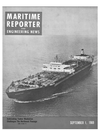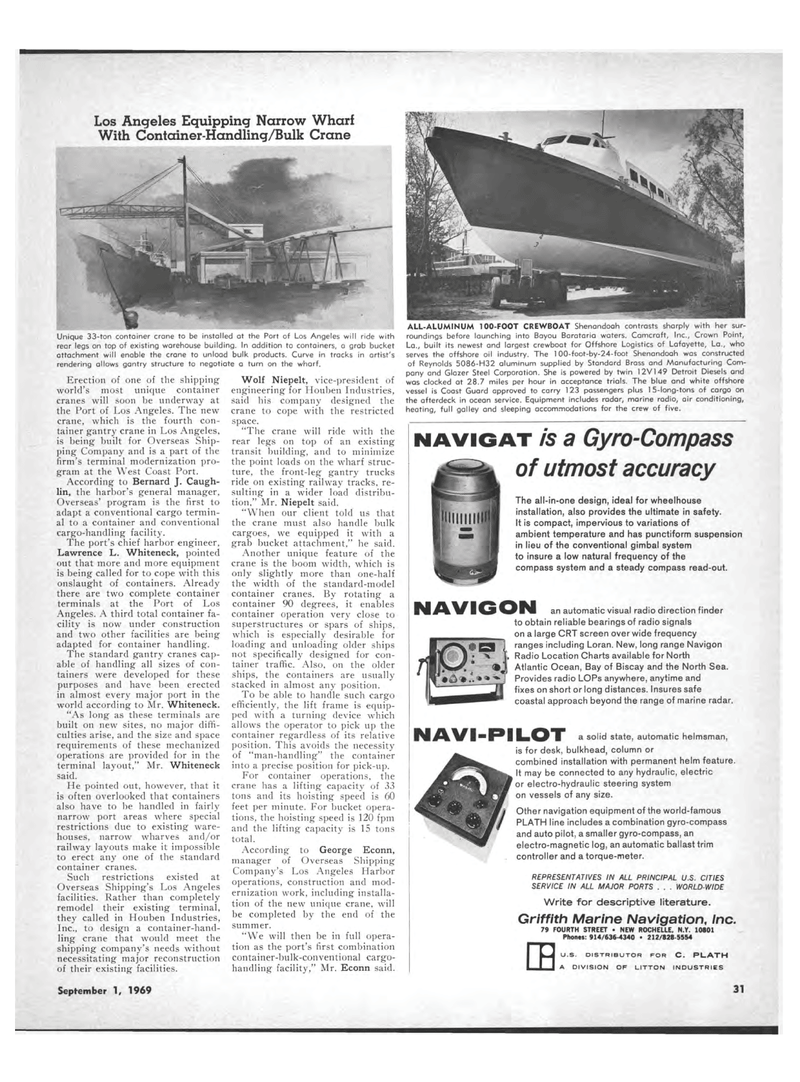
Page 29: of Maritime Reporter Magazine (September 1969)
Read this page in Pdf, Flash or Html5 edition of September 1969 Maritime Reporter Magazine
Other navigation equipment of the world-famous PLATH line includes a combination gyro-compass and auto pilot, a smaller gyro-compass, an electro-magnetic log, an automatic ballast trim controller and a torque-meter. REPRESENTATIVES IN ALL PRINCIPAL U.S. CITIES SERVICE IN ALL MAJOR PORTS . . . WORLD-WIDE Write for descriptive literature. Griffith Marine Navigation, Inc. 79 FOURTH STREET ? NEW ROCHELLE, N.Y. 10801 Phones: 914/636-4340 ? 212/828-5554 mu-s. DISTRIBUTOR FOR C. PLATH A DIVISION OF LITTON INDUSTRIES ALL-ALUMINUM lOO-FOOT CREWBOAT Shenandoah contrasts sharply with her sur-roundings before launching into Bayou Barataria waters. Camcraft, Inc., Crown Point, La., built its newest and largest crewboat for Offshore Logistics of Lafayette, La., who serves the offshore oil industry. The 100-foot-by-24-foot Shenandoah was constructed of Reynolds 5086-H32 aluminum supplied by Standard Brass and Manufacturing Com-pany and Glazer Steel Corporation. She is powered by twin 12V149 Detroit Diesels and was clocked at 28.7 miles per hour in acceptance trials. The blue and white offshore vessel is Coast Guard approved to carry 123 passengers plus 15-long-tons of cargo on the afterdeck in ocean service. Equipment includes radar, marine radio, air conditioning, heating, full galley and sleeping accommodations for the crew of five. Los Angeles Eguipping Narrow Wharf With Container-Handling/Bulk Crane Unique 33-ton container crane to be installed at the Port of Los Angeles will ride with rear legs on top of existing warehouse building. In addition to containers, a grab bucket attachment will enable the crane to unload bulk products. Curve in tracks in artist's rendering allows gantry structure to negotiate a turn on the wharf. Erection of one of the shipping world's most unique container cranes will soon be underway at the Port of Los Angeles. The new crane, which is the fourth con-tainer gantry crane in Los Angeles, is being built for Overseas Ship-ping Company and is a part of the firm's terminal modernization pro-gram at the West Coast Port. According to Bernard J. Caugh-lin, the harbor's general manager, Overseas' program is the first to adapt a conventional cargo termin-al to a container and conventional cargo-handling facility. The port's chief harbor engineer, Lawrence L. Whiteneck, pointed out that more and more equipment is being called for to cope with this onslaught of containers. Already there are two complete container terminals at the Port of Los Angeles. A third total container fa-cility is now under construction and two other facilities are being adapted for container handling. The standard gantry cranes cap-able of handling all sizes of con-tainers were developed for these purposes and have been erected in almost every major port in the world according to Mr. Whiteneck. "As long as these terminals are built on new sites, no major diffi-culties arise, and the size and space requirements of these mechanized operations are provided for in the terminal layout," Mr. Whiteneck said. He pointed out, however, that it is often overlooked that containers also have to be handled in fairly narrow port areas where special restrictions due to existing ware-houses, narrow wharves and/or railway layouts make it impossible to erect any one of the standard container cranes. Such restrictions existed at Overseas Shipping's Los Angeles facilities. Rather than completely remodel their existing terminal, they called in Houben Industries, Inc., to design a container-hand-ling crane that would meet the shipping company's needs without necessitating major reconstruction of their existing facilities. Wolf Niepelt, vice-president of engineering for Houben Industries, said his company designed the crane to cope with the restricted space. "The crane will ride with the rear legs on top of an existing transit building, and to minimize the point loads on the wharf struc-ture, the front-leg gantry trucks ride on existing railway tracks, re-sulting in a wider load distribu-tion," Mr. Niepelt said. "When our client told us that the crane must also handle bulk cargoes, we equipped it with a grab bucket attachment," he said. Another unique feature of the crane is the boom width, which is only slightly more than one-half the width of the standard-model container cranes. By rotating a container 90 degrees, it enables container operation very close to superstructures or spars of ships, which is especially desirable for loading and unloading older ships not specifically designed for con-tainer traffic. Also, on the older ships, the containers are usually stacked in almost any position. To be able to handle such cargo efficiently, the lift frame is equip-ped with a turning device which allows the operator to pick up the container regardless of its relative position. This avoids the necessity of "man-handling" the container into a precise position for pick-up. For container operations, the crane has a lifting capacity of 33 tons and its hoisting speed is 60 feet per minute. For bucket opera-tions, the hoisting speed is 120 fpm and the lifting capacity is 15 tons total. According to George Econn, manager of Overseas Shipping Company's Los Angeles Harbor operations, construction and mod-ernization work, including installa-tion of the new unique crane, will be completed by the end of the summer. "We will then be in full opera-tion as the port's first combination container-bulk-conventional cargo-handling facility," Mr. Econn said. The all-in-one design, ideal for wheelhouse installation, also provides the ultimate in safety. It is compact, impervious to variations of ambient temperature and has punctiform suspension in lieu of the conventional gimbal system to insure a low natural frequency of the compass system and a steady compass read-out. NAVIGON an automatic visual radio direction finder to obtain reliable bearings of radio signals on a large CRT screen over wide frequency ranges including Loran. New, long range Navigon Radio Location Charts available for North Atlantic Ocean, Bay of Biscay and the North Sea. Provides radio LOPs anywhere, anytime and fixes on short or long distances. Insures safe coastal approach beyond the range of marine radar. NAVIGAT /s a Gyro-Compass of utmost accuracy N^V^^l?^® I Lb^^^T a solid state, automatic helmsman, is for desk, bulkhead, column or combined installation with permanent helm feature. It may be connected to any hydraulic, electric MBjt&Bk WtSSm or electro-hydraulic steering system on vessels of any size. September 1, 1969 31

 28
28

 30
30
